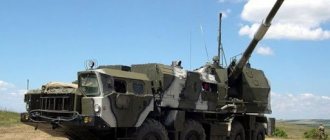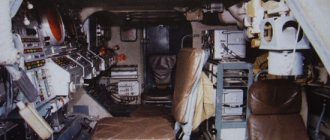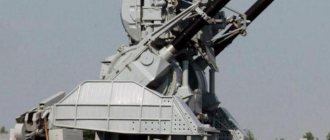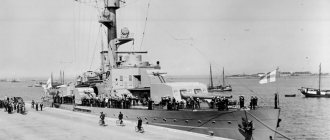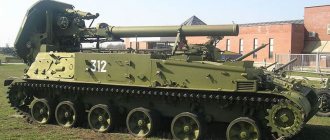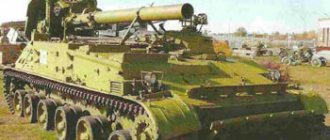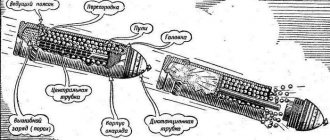The state of Russian coastal artillery at the beginning of the 20th century, as in all subsequent years, was kept in a state of strict secrecy. In particular, this factor was due to the fact that these weapons were initially required to be invisible. Both monarchist and Soviet coastal artillery were located in special zones to which ordinary people simply did not have access. At that time, huge battleships and cruisers were brought to the fore, which immediately attracted attention with their size, but in terms of long service they could not compete with coastal batteries. This article will describe the history of Russian coastal artillery in the 20th century, its condition and the most famous models used.
Historical reference
Coastal artillery guns in Russia began to be used quite early, but their real history begins only in 1891. It was then that new models of batteries with long barrels, which were the most modern model, entered production. With their efficiency, they completely replaced the old guns, and therefore began to have prevailing importance as coastal systems.
The history of coastal artillery is inextricably linked with the history of the Russian fleet, however, its organization and activities were quite distant from it. They were subordinate exclusively to the Main Artillery Directorate, which undoubtedly had a number of both positive and negative aspects. The first exception to this rule was made only in 1912, when the Peter the Great fortress protecting the Gulf of Finland was transferred to the authority of the Maritime Department.
Examples[edit]
In the United Kingdom
British coastal guns outside the UK
USA
Canada
Asia
| Nazi Germany
South and Central America
Australia
Another
|
Coastal artillery of the USSR
After the October Revolution and the Soviets coming to power, all coastal batteries were placed under the direct command of the Red Army, and only in 1925 did they come under the authority of the Chief of the Naval Forces. However, such development took place over a relatively short period of time - all work in this area, by order of the head of the country Nikita Khrushchev, on the construction of Russian coastal artillery was stopped in 1957. After this, the systems began to be gradually dismantled; in rare cases, they were simply mothballed. Even photographs of coastal artillery of those years, as well as numerous documentation on this issue, were simply destroyed or lost.
This system began a new round of development only in 1989, when coastal troops were allocated to the Navy. At the moment, all coastal artillery is under the control of this department.
Coastal defense in the modern world: recent history
Coastal defence.
This, if you look in the dictionary of terms, is a combination of naval forces and assets with fortifications and a system of anti-landing and anti-aircraft structures designed to protect naval bases, ports and important coastal areas. Cumbersome. Let's also look at anti-landing defense?
Anti-landing defense (ADD) of the coast - a set of measures aimed at the defense of the coastal strip (coast) by coastal troops (coastal missile and artillery troops) or ground forces in cooperation with the navy and aviation (Air Force) in order to prevent the landing of sea and airborne assault forces enemy.
It’s already more or less clear.
It turns out that coastal defense is if the fleet is involved, anti-landing defense is if it is not.
Anti-landing defense as such, in my opinion, was formed during the Second World War. A classic example is the events on the coast of France, with the help of which the Germans wanted to prevent the Allied landings.
It looked ominous, but did not help much during Operation Overlord, as we all remember.
Coastal defense is a very ancient thing. The BO troops are also very old. In general, as soon as humanity left the shore and began to swim along it, it was almost immediately necessary to guard and defend this shore. Because everyone turned out to be smart, and going to a neighbor to steal something became good manners and easy money at the same time.
Well, sailing to Troy or Syracuse to fight is generally a classic.
So, most likely, coastal defense troops appeared long before any artillery and other newfangled things.
But their role has not changed very much since the times of Ancient Greece and Ancient Rome: to keep the enemy fleet away from their shores, preventing the landing of enemy troops with subsequent robbery or seizure of territories and the fire of enemy ships on their ground targets.
Only the ancients used ballistas, catapults and scorpions for “fire impact”, and today, of course, the toys are more interesting.
Until the middle of the last century, the concepts of “coastal defense” and “coastal artillery” were synonymous. It’s just that there was nothing else in terms of weapons, so they all defended their shores with cannons concentrated in batteries.
The batteries were installed in forts covering ports, on sections of the coast where landings could be made. Naturally, the batteries were stationary, since they used ship guns. And the further we got towards the middle of the 20th century, the more terrible the coastal batteries began to look, which received gun turrets from heavy cruisers and even battleships.
The latter turned out to be quite a good and effective weapon against ground forces who would like to approach the defended objects.As examples, we can easily cite the batteries of Sevastopol and Leningrad, which quite successfully and effectively fired at the advancing troops of the European team under the leadership of the Germans. The Allies can recall Fort Drum as part of the Philippine archipelago.
In general, artillery fought in coastal defense for several centuries from Dover to Cartagena. And she fought well.
There was even such a class of ships as coastal defense battleships.
After World War II, coastal artillery batteries began to be replaced by anti-ship missile (ASM) battalions. As a rule, all countries that started such a replacement used the same anti-ship missiles that were on their ships to defend their shores.
Anti-ship missiles turned out to be no less, and in some cases, more effective weapons. And - importantly - cheap. That is, a coastal installation of anti-ship missiles was definitely cheaper than a ship armed with such missiles. But the range was also more modest, since the anti-ship missiles were installed on the shore.
But the coastal anti-ship missile installation could be camouflaged and covered with air defense systems. Or make it maneuverable by installing it on mechanical traction. But if it arrives, it arrives.
And then, after all, the coastal installation of anti-ship missiles (and any coastal defense system of the past) is still passive, and the initiative in battle has always belonged and will belong to the attacking enemy fleet.
By the way, this is precisely why some countries abandoned coastal defense altogether or left the main role in defense to the navy, and assigned the BC a support role.
But it’s one thing if the country’s coastline and budget are similar to those of Estonia or Lithuania, and another thing if it’s Russia or the USA. Which have a coastline from one ocean to another.
Let’s leave the USA alone for now; their coastal defense has generally gone its own way of development, but let’s take the USSR.
When the leadership of the now deceased country realized that the country would not be able to fight on equal terms in a possible conflict with the NATO fleet, then, taking into account the experience of the Great Patriotic War, when coastal defense showed itself well, they decided to strengthen the fleet with the help of BO.
And the coastal defense, which was part of the USSR Navy, began to develop at a very rapid pace, since such expenses as for the construction of missile cruisers were not required.
And one of the first in the world (perhaps the very first), the coastal defense of the USSR Navy began to switch to missile weapons.
This did not mean at all that the artillery was scrapped, no. Coastal batteries actually served until the 70s of the last century. But in the 50s, missile systems began to receive registration on Soviet shores.
I am sure that among the readers there will be those who will recall with aspiration how they served with this “miracle weapon.”
The first-born of the Soviet coastal defense was the Sopka anti-ship missile system with the Comet anti-ship missile system, which was put into service in 1958.
In 1966, the more advanced Redut anti-ship missile system with supersonic P-35 anti-ship missiles took over the coastal defense. The same missiles were carried by missile cruisers of Project 1134 code "Berkut", which have now become history.
In 1978, the coastal anti-ship missile system "Rubezh" with the P-15 anti-ship missile system entered service. Project 183 and 205 missile boats were armed with these missiles. The products were tested in combat; the Egyptian and Indian (especially) fleets successfully fought with these missiles against the Israeli and Pakistani fleets.
As you can see, every 10 years the BPKRK was replaced with a more modern one. But alas, when, with the next change of course, the USSR began to create an ocean-going fleet and overstrained itself on this, naturally, coastal missile systems were also affected.
As a result, we approached the collapse of the USSR without ships and without the BPKRK. And the situation worsened every year.
The breakthrough came only in 2008, when, 30 years later, Russia’s coastal defense received a new “Bal” complex with X-35 anti-ship missiles.
And two years later, in 2010, “Bastion”, the most modern complex with the most advanced, in my opinion, anti-ship missile system “Onyx”, was put into service.
Today, coastal missile brigades of the Russian Navy, armed with both types of BRPKR, are on duty to protect the coastline and facilities. This is logical and justified, since the brigade consists of two divisions of the “Bastion” BPKRK with a range of up to 500 km and the “Bal” BPKRK with a range of up to 260 km.
In the "Bal" anti-ship missile launcher division there are 4 launchers with 8 anti-ship missiles on each, in the "Bastion" division - 4 launchers and 4 TZM - 2 anti-ship missiles on each.
The brigades, however, are not enough.
536th brigade of the Northern Fleet (stationed in the village of Guba Olenya, Murmansk region). 25th brigade of the Baltic Fleet (Donskoye village, Kaliningrad region). 11th brigade of the Black Sea Fleet (Utash village near Anapa, Krasnodar Territory). 15th brigade of the Black Sea Fleet (Sevastopol). 520th brigade of the Pacific Fleet (Anglichanka village near Petropavlovsk-Kamchatsky). 72nd brigade of the Pacific Fleet (settlement Smolyaninovo near Vladivostok) brigade of the Pacific Fleet.
Moreover, the 72nd brigade of the Pacific Fleet was scattered. One division of “Bastions” covers Vladivostok itself, the second division of “Bastions” is sent to the island of Iturup in the Kuril ridge, and the division “Balov” is sent to the island of Kunashir.
In addition to these brigades, there is also a separate battery of the Bastion anti-ship missile system (2 launchers) on the New Siberian Islands. If you look at the map, it will become absolutely clear that the complexes are there for a reason.
There is also the 51st coastal missile division of the SCRC “Bal” as part of the Caspian Flotilla.
In general, not much, to be honest. Considering the length of our coastline... But better than nothing, better than useless old cruisers that are beyond repair, and aircraft carriers that are only beautiful on paper.
Meanwhile, the Black Sea Fleet still has the 11th brigade, which is armed with two divisions with “Redoubts” and (!) the 459th separate coastal artillery division. The 459th Obad is armed with 130-mm A-222 Bereg guns.
This is the last artillery unit in our coastal defense.
True, the Black Sea Fleet also includes the 15th brigade, stationed in Sevastopol. The brigade is armed with one “Bastion” division and one “Balov” division. The third division of the brigade is armed with the Utes anti-ship missile system and the silo-based 3M44 Progress anti-ship missile system.
For comparison: the coastal defense of the People's Liberation Army of China has 10 brigades.
But in NATO, only three countries have coastal defense forces.
Spain is a unique country; its coastal defense forces, which, by the way, are part of the ground forces, have only coastal artillery of 155-mm guns SBT155/52APUSBTV07). There are no missiles at all.
The Polish Navy recently adopted two batteries of the Norwegian NSM anti-ship missile system (12 launchers, 4 anti-ship missiles each).
Croatia is armed with three batteries of the Swedish RBS-15K anti-ship missile system and 21 artillery batteries.
The Swedes themselves have 6 RBS-15KA launchers, as well as 90 RBS-17 launchers, this is actually an anti-ship version of the American Hellfire ATGM, dangerous only for small targets such as MRKs.
Finland has 4 RBS-15K launchers and coastal artillery - 30 K-53tk guns, 72 K-54RT (Soviet M-46), 1.130K90–60 (130 mm).
If you look at the European theater of operations this way (we don’t take the Asia-Pacific region, in fact we are not there), then in comparison with NATO countries, everything is fine with us.
However, who would attack Spain, and, in principle, Sweden too?
As for our two puddles, the Black Sea and the Baltic, everything is fine there. I mean, if you have to fight off anyone, that is, with what. I’m generally silent about the Caspian Sea.
But I would not be so optimistic about covering the Northern Fleet and the Pacific Fleet. The spaces are huge, and in the Pacific Fleet the neighbors are such that if you have more than a couple, you don’t need any enemies at all. And the islands seem to be controversial for Japan, and the coastline is so... rather large.
In general, there is a lot of work there in terms of (in a good way) the formation of at least four SCRC brigades, two per fleet.
And here it is, the question.
Dear readers, who is in control? We bring to your attention the following reflection: is it worth it?
Is it worth building all these vague and incomprehensible mosquito RTOs, sub-corvettes, etc.? And different projects, with different propulsion systems, and even with eternal problems with the engines? We can’t build it ourselves, we buy from China, fortunately at least it’s still selling.
Isn’t it better to stop the process of frankly stupid (but profitable) budget development in the construction of very strange corvettes with Caliber cruise missiles, but completely without anti-submarine weapons and with very weak anti-aircraft weapons?
The INF Treaty no longer exists, and all these “mosquitoes” were designed to circumvent this Treaty, so is it worth blocking everything?
After all, in theory, we can simply solve a bunch of problems: not build ships that we are not able to build, not “import-substitute” diesel engines that cannot be replaced, but simply take and build anti-ship missile systems, placing them in key areas?
Plus, of course, mobile launchers based on wheeled platforms.
How do you like this option?
Kane's guns
After their appearance in 1891, the Kane system guns created a real sensation. They marked the beginning of a new era, capturing not only coastal artillery, but also naval artillery. During the period of their dominance, various cruisers such as the Varyag, Potemkin and even the Aurora were widely equipped with them. This gun was the first example of a 6″ gun with a long barrel, a fast bolt and a cartridge charge, which not only made it possible to quickly reload it, but also dramatically increased the accuracy and armor-piercing power of the gun.
This gun was invented in France, but the Russian delegation did not order weapons from another country, but only purchased a sample of the drawings. Their production soon began. In total, by decree of Emperor Nicholas II, 1 6″/50 cannon was created, but it did not show sufficient effectiveness, so it was ordered to return to the 6″/45 system, as indicated in the drawings.
In total, such a weapon consisted of 3 parts: a coupling, a casing and a barrel. It fired projectiles measuring more than a meter and weighing 43 kg. The gun was widely used until the end of the 40s of the 20th century.
Modernization No. 194
In 1926, the Ordnance Department ordered the modernization of Kane's guns. Their main requirement was a sharp increase in the elevation angle - it was additionally required to increase it by another 60 degrees. This would have helped the coastal artillery learn anti-aircraft shooting, but they could not do this.
However, instead of this, LMZ presented a prototype of gun No. 194. Surprisingly, during the tests, despite the fact that neither the accuracy nor the rate of fire of the gun was determined, it was still accepted for production. For several more years it continued to be modernized, since Kane’s guns were noticeably outdated. As experience has shown, their renewal was impossible in practice, so there was an urgent need to create a fundamentally new coastal artillery according to new canons. In total, 281 different models were created based on the Kane gun, none of which could fully satisfy the desires of the military.
Coastal guns 10″ in 45 klb
In addition to Kane's guns, in the 90s of the 19th century, coastal guns of 254 mm, that is, 10″/45, were adopted. They were intended exclusively for coastal protection. In particular, this is due to 2 factors: the artillery committee’s fear of any innovations and the adoption of such guns in the fleet. At that time, in the Russian fleet, unlike the Western one, they preferred to use physical force to aim the gun and supply ammunition, rather than electric drives.
Unfortunately, in practice, such guns showed that their installation was noticeably delayed by at least a decade. At that time, Western battleships became noticeably more massive, as did the guns used on them. Such technical illiteracy among senior military personnel led to subsequent defeats.
However, even in the very structure of the cannon, the generals were let down by conservatism. They set out to create a fundamentally new gun and carriage, sharply different from the naval ones. Ultimately, a rolling machine system was created, which made the design even more obsolete. All this led to the fact that work on them was suspended, but, surprisingly, it was resumed a few years later. Thus, coastal artillery began to use guns that had numerous disadvantages. Their main spectrum was installed in Port Arthur. Similar guns, with a subsequent series of upgrades, were used until 1941.
Composition A-222 "Bereg"
The A-222 “Bereg” artillery complex includes:
- 1x Central post with fire control system
- 6 x self-propelled guns with 130 mm guns
- 1-2 Combat duty support vehicles.
The basis for all Bereg components is the MAZ-543M all-terrain chassis with an 8x8 wheel arrangement. the use of a wheeled chassis is determined by the nature of the application - compared to a tracked one, it gives an almost twofold increase in the power reserve and a threefold increase in the guaranteed mileage of the vehicles. The fuel supply is sufficient to move the complex's vehicles over a distance of 850 km at a speed of 60 km/h.
Central post of the coastal defense complex A-222 "Bereg"
Central post
The central post van body has five compartments:
- motor
- antenna post
- high frequency
- radio operator
- operator
The engine compartment contains a diesel-electric backup power source (in the absence of power from the support vehicle or centralized power grids) with a rated power of 30 kW of alternating three-phase current with a frequency of 50 Hz and a voltage of 380/220 V with an isolated neutral, as well as a machine converter with a secondary voltage of 220 V frequency 400 Hz and 15 kW power to power the fire control system.
In the antenna post compartment, on a retractable base, there are transmitting and receiving devices of the control system: an all-round radar antenna with its own rotation drive, as well as a rangefinder and sighting device for an optical-electronic target detection and tracking channel. When deployed on uneven terrain, the van body has jacks, with the help of which the calculation can make the plane of rotation of the antenna horizontal. The jacks have not only electromechanical, but also manual drives, which allows you to deploy the antenna even in an emergency. In the front part of the van body above the vehicle cabin, two air conditioners are installed - one for the instrument ventilation system, the other for the crew’s life support system.
Self-propelled guns of the A-222 “Bereg” coastal defense complex. 130 mm.
Self-propelled gun A-222 "Bereg"
Self-propelled guns have 1x 130-mm gun in a turret that rotates on a slewing ring. The gun is aimed by an electromechanical system, which has targeting modes: automatic - using digital codes coming from the Central Post, and semi-automatic, performed by the gunner using the gun mount's sighting devices. In the latter case, it is assumed that the self-propelled guns participate in combat operations autonomously and have no connection with the CPU and MOBD.
The turret is equipped with workplaces for the commander, gunner and four loaders. At the commander’s workplace there is a control unit for the operation of all systems (fire control, guidance, ammunition supply, cartridge case removal, life support, fire extinguishing), an optical-electronic commander’s observation device with a night channel, a quantum range finder, a ballistic computer and a tablet for autonomous operation, a radio station, equipment control of internal and external wired intercom, lighting and heating equipment.
The gunner at his workplace has an optical sight, a light signaling unit, as well as lighting and intercom equipment. If any obstacles may fall into the shooting zone, the gunner can take this circumstance into account by entering information into a special block for entering the coordinates of prohibited shooting zones, located at his workplace.
The workstations of the two front loaders are organized at the shot feed trays symmetrically to the axis of the barrel bore. The rear loaders' positions are located at the ammunition racks and their loading device. There are also two stowages for storing and transporting 40 unitary rounds with high-explosive and high-explosive fragmentation projectiles. To absorb sound impact and external heat, the inner covering of the tower is made of a special synthetic foam material. Most of the gun mechanisms inside the turret are sealed. In addition, a fan is installed in the turret, which reduces air pollution during firing. Air intake is carried out through a pipe raised above the roof.
The self-propelled gun at the firing position is leveled by four jacks, which ensure chassis rigidity when firing. Movements during the shooting process are taken into account by a correction input system, including roll sensors and an optical sight. Next to the movable turret, an aggregate compartment is installed on a vehicle chassis, which contains a power unit for driving two electric machine amplifiers of the gun guidance system, a DC generator to power the jacks, as well as batteries and units of power supply, guidance and fire control systems.
Combat duty support vehicle, central post and 130-mm self-propelled guns of the Bereg complex
Combat duty support vehicles A-222 "Bereg"
The support machine has:
- a removable power supply unit with two diesel electric units with a rated power of 30 kW each of alternating three-phase current with a frequency of 50 Hz and a voltage of 380/220 V with an insulated neutral to ensure uninterrupted stabilized power supply to the Central Post systems during long-term duty at the firing position;
- fuel tanks designed for continuous operation of diesel units for 7 days;
- double and four-seat compartments for rest of personnel;
- 4-seater dining-room;
- an equipped kitchen with food supplies that can serve ten people for 7 days.
To organize close-in defense, a turret machine gun mount is mounted on the roof of the vehicle.
The MOBD van body also contains special equipment to notify the crew about radiation and chemical contamination, and navigation equipment for the complex (or individual vehicles) to enter a given area. There are special cabinets for drying clothes and shoes with electric heaters and a fan, as well as for personal chemical protective equipment, ammunition, gas masks, personal weapons, portable battery lamps and tanks with drinking and household water.
130-mm self-propelled gun based on MAZ-543M with a gun in stowed position
Coastal guns 120/50 mm
It was the loss in the Russo-Japanese War that showed the need to update the existing coastal artillery, which led to the appearance of new 120/50 mm guns. This whole war led to the enrichment of a group of swindlers associated with the Grand Dukes of the Romanovs. One of them was Basil Zakharov. It was he who sold more than 20 Vickers 120/50 mm guns. It was not used during the war, and simply could not have been. Gradually, after a series of transportations, they settled in Kronstadt. Initially, they began to be installed on ships, like the newly built Rurik, so their production began. It is not clear why, but the military department also placed a large order for coastal artillery. These guns had excellent ballistics, but their caliber was too small to deliver a significant blow to cruisers or battleships. However, due to their light weight, they gained significant popularity in coastal defense and ground forces during the First World War.
Characteristics of the 130-mm coastal artillery complex A-222 "Bereg"
A country:USSR/RussiaType:Coastal defense complexDate of issue:1992 (1988)Calculation:7 people (Central post) 8 (SPG) 4 (Support vehicle)Caliber:130 mmLength:15.2 m (Central post) 13.0 m (SPG) 15.94 m (Support vehicle)Width:3.24 m (Central post) 3.1 m (SPG) 3.23 m (Support vehicle)Weight:43.7 tons (Central post), 43.5 tons (self-propelled guns).Rate of fire:72 rounds/minFiring distance:22 km (target detection - at least 35 km)Initial projectile speed:Ammunition:
Gun 6″/52
This gun was originally built as an improved version of the Cane guns with better ballistics and an increased rate of fire. They began to produce them only in 1912 in order to be able to fire different shells - high-explosive, armor-piercing and even shrapnel. At the perfect stage of their design, they could effectively withstand battleships during the Second World War, but their production, despite the fact that the prototype proved to be the most ideal coastal installation in the whole world, could not be completed. Their production was discontinued in 1917, after which the issue of completion was never returned. Thus, due to mismanagement, one of the best coastal guns was lost.
Single-gun open installations
In addition to cannons, open installations were also used as coastal artillery. Of these, the 12″/52 installation has gained the most popularity. The gun carriage design was in many ways similar to the ship's machines installed on the battleship Sevastopol. In their finished form, after delivery, they could well be called ersatz installations for wartime. Perhaps that is why they were used even during the Second World War. The most famous battery, Mirus, showed its combat effectiveness until the very end of the war, after which it was given to the British.
Links[edit]
- Peter Doyle; Matthew R. Bennett (2002). Battlefields: Terrain in Military History
. Dordrecht: Kluwer Academic. ISBN 1-4020-0433-8. - The three-mile limit is often circumvented by boats offering gambling or party cruises. Beyond three miles, restrictive state laws are relaxed so that gambling or drinking among teenagers in the United States becomes unenforceable in the courts.
- Weaver II, John R. (2018). A Legacy of Brick and Stone: American Coastal Defense Forts of the Third System, 1816-1867, 2nd ed
. McLean, VA: Redoubt Press. pp. 16–17, 24–34. ISBN 978-1-7323916-1-1. - Hogg, Ian W. (2002). British and American artillery from World War II
. Mechanicsburg, PA: Stackpole Books. pp. 180–181. ISBN 1-85367-478-8. - George Floyd Duckett (1848). Military Technology Dictionary, German-English-French. paragraph 201.
- John Gross Barnard (1861). Notes on Coastal Defense. D. Van Nostrand. paragraph 48. ground battery.
- Civil War Forces Digital Research Library (2004). "Batteries, river and coastal defence". Dictionary of Fortification
. Retrieved December 14 +2016. - Glenn Tucker (2015). Chickamauga: Bloody Battle in the West. Published by Pickle Partners. ISBN 9781786251152. Hamilton experimented with an armored floating battery, and Stevens created an armored land battery.
- Rutter (1867). "Large Armored Battery of Floating Guns for Bay and Harbor Defense". Illustrated Sydney News - via Trove - National Library of Australia. [floating battery] will have all the advantages of a land battery combined with the ability to move
- ↑
See "Coast Artillery Organization: A Brief Overview," Bolling W. Smith and William C. Gaines, in the 2008 update to Defense of the American Coast, Mark Berhow, ed., CDSG Press, McLean, VA, 2004. Online -A version of this article can be found here. - Smith 2006, pp. 442–443 and 527.
- Kirby 1954, p. 361.
- Jump up
↑ Chung 2011, pp. 24–26. - ↑ abc Chung 2011, p. 26.
- Karig, commander Walter; Burton, Lieutenant Earl; Freeland, Lt. Stephen L. (1946). Battle Report (Volume 2); Atlantic War
. New York/Toronto: Farrar and Rinehart, Inc., pp. 386–387. - Burton, Earl (September 2004). "Another D-Day: The Invasion of Southern France". Nautical classics
.
37
(9):60–70. Retrieved June 23, 2009. - "Altair Agencja Lotnicza". www.altair.com.pl
. Retrieved March 29, 2022.
Three-gun turret installations
By 1954, three-gun installations appeared in the coastal artillery. Their design began back in 1932, after which many upgrades were made to create an effective system. However, they were able to bring it to fruition only after the appearance of a gun-guided radar station called “Zalp-B”. This made it possible to significantly improve accuracy, as well as significantly expand the capabilities of the entire installation. Ultimately, they were transferred to Ukraine in 1996, since they had largely lost their constructive novelty and could not bring good results.
Ultra-long-range guns
Back in 1918, experienced artillery specialists tried to create an ultra-long-range firing system. However, during the formation of the Soviet Union, it was not possible to create fundamentally new systems, so their task was to make special projectiles. For the first time, a significant result was shown only in 1924, when a charge weighing one hundredweight was built, which could fly at a speed of 1250 m/s. However, it had one major drawback - large dispersion. After that, it was constantly modified in order to remove existing shortcomings, but until the war it was not possible to achieve results. After this, development was forgotten for a short period and was resumed only in 1945. The breakthrough was made by captured German designers, creating the easiest and cheapest installation option. Even now, most of the drawings created during that period on this issue are secret.
In addition to the above-mentioned guns and installations, a large number of models were used in coastal artillery, some with success, but many quite unsuccessfully. At the present stage of development, the coast guard system continues to develop, since it is one of the most important agendas in the Navy.
